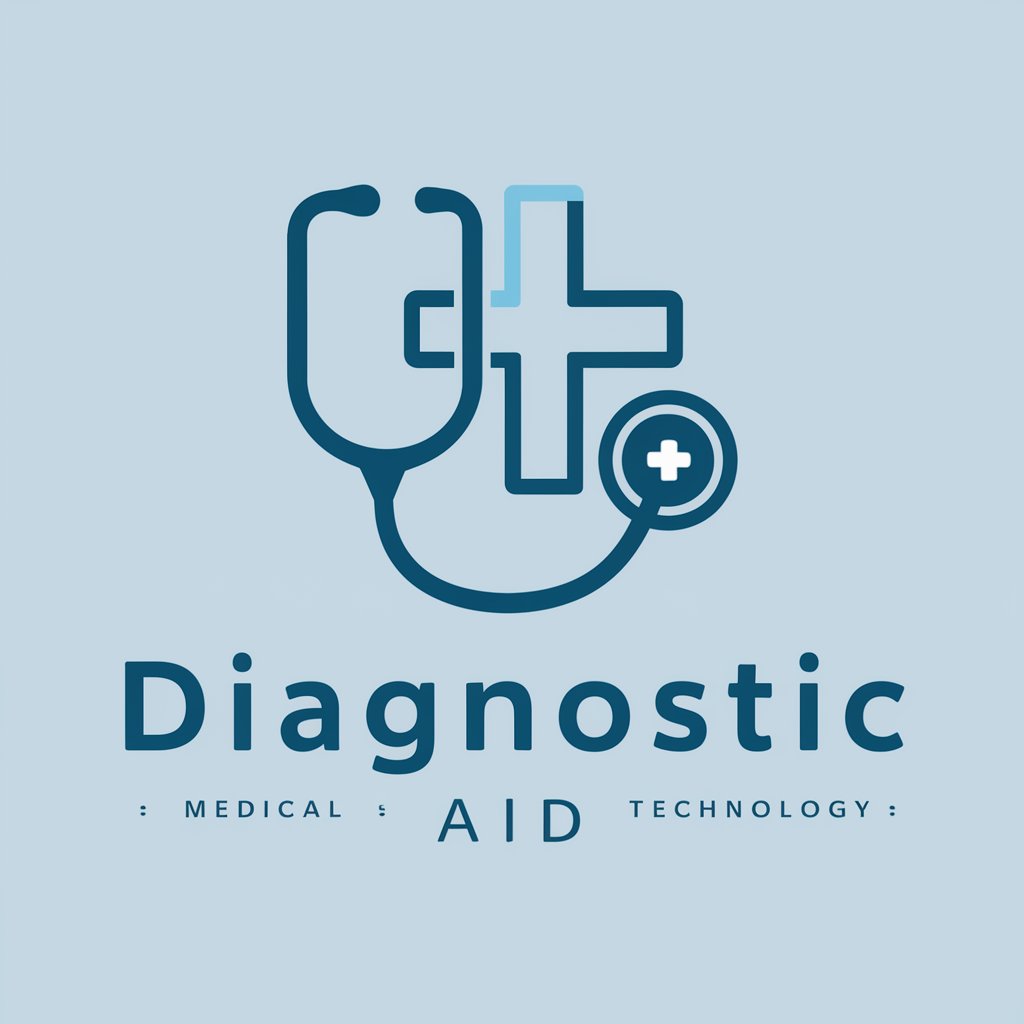Diagnostic Aid - Medical Diagnostic Guidance

Welcome to Diagnostic Aid, your professional medical support tool.
Empowering diagnostics with AI assistance
Patient presents with...
Considering the symptoms of...
What are the differential diagnoses for...
Describe the pathophysiology of...
Get Embed Code
Overview of Diagnostic Aid
Diagnostic Aid is a specialized AI tool designed for the medical community, offering support in the diagnostic process through the analysis of patient symptoms and medical histories. It serves as a digital assistant to healthcare professionals by providing a comprehensive, updated database of medical knowledge, including current research findings and clinical guidelines. The primary aim of Diagnostic Aid is to enhance clinical decision-making by suggesting potential diagnoses and delivering in-depth information on various medical conditions. For example, when a clinician enters symptoms such as 'fever, cough, and shortness of breath,' Diagnostic Aid might suggest possible conditions like COVID-19, influenza, or bacterial pneumonia, while also providing the latest treatment guidelines and evidence-based recommendations for further testing. This tool is designed not to replace clinical judgment but to augment it with accessible, detailed medical information, aiding in the consideration of a broad range of diagnostic possibilities. Powered by ChatGPT-4o。

Core Functions of Diagnostic Aid
Symptom Analysis
Example
Analyzing inputted symptoms to suggest possible diagnoses.
Scenario
A general practitioner inputs symptoms of 'abdominal pain, bloating, and diarrhea' into Diagnostic Aid. The tool then lists conditions such as irritable bowel syndrome (IBS), celiac disease, and Crohn's disease, alongside key diagnostic criteria and recommendations for initial management.
Medical Literature Access
Example
Providing access to up-to-date medical research and guidelines.
Scenario
An oncologist queries Diagnostic Aid for the latest treatment protocols for non-small cell lung cancer. The tool provides summaries of the most recent clinical trials, guidelines from oncology societies, and personalized therapy options based on tumor genetics.
Treatment Recommendation
Example
Offering evidence-based treatment options for diagnosed conditions.
Scenario
A pediatrician uses Diagnostic Aid to find the most effective treatment for pediatric asthma. The tool outlines step-by-step management plans including lifestyle modifications, inhaler techniques, and when to escalate therapy, all based on the latest asthma guidelines.
Risk Factor Identification
Example
Highlighting potential risk factors based on patient history and symptoms.
Scenario
A cardiologist inputs a patient's symptoms of 'chest pain, shortness of breath, and dizziness.' Diagnostic Aid suggests considering coronary artery disease, highlighting risk factors such as high cholesterol, hypertension, and smoking history in the patient's profile.
Target User Groups for Diagnostic Aid
Healthcare Professionals
This includes doctors, nurses, physician assistants, and other clinical staff who can utilize Diagnostic Aid to enhance diagnostic accuracy, stay updated on medical literature, and streamline patient care. It's particularly beneficial for those in primary care or specialties where a broad differential diagnosis is common.
Medical Researchers
Researchers can use Diagnostic Aid to quickly access a vast database of medical literature for their studies, facilitating literature reviews, hypothesis generation, and identification of research gaps in their field of study.
Medical Students and Residents
For those in training, Diagnostic Aid serves as an educational tool, helping to bridge the gap between theoretical knowledge and clinical practice. It aids in learning about the presentation of various diseases, understanding diagnostic pathways, and keeping abreast of current medical guidelines.

How to Use Diagnostic Aid
Start Your Journey
Visit yeschat.ai for a complimentary trial, accessible without signing up or subscribing to ChatGPT Plus.
Identify Your Needs
Consider what information or diagnosis you're seeking. Diagnostic Aid can assist with a wide range of medical inquiries, from differential diagnoses to detailed information on specific conditions.
Input Patient Symptoms
Provide detailed descriptions of the patient's symptoms, including onset, duration, and any associated factors. The more detailed the information, the more accurate the guidance.
Review Suggestions
Examine the potential diagnoses and information provided. Use this as a starting point for further research or to guide diagnostic testing and treatment planning.
Consult Relevant Literature
Always cross-reference the suggestions with the latest medical literature and guidelines. Diagnostic Aid is a tool to assist with initial assessment, not a substitute for professional medical advice.
Try other advanced and practical GPTs
Career Companion
Empowering Your Career Journey with AI

historyX
Explore History with AI-Powered Insights

Saito.ai
Automate crypto transactions with AI

Business Development & Digital Marketing Plan
Empowering Growth with AI-Driven Strategies

Story Plot Twist Generator
Unleash creativity with AI-powered plot twists

Edgar
Crafting Deep, Immersive Horror

AI Edu Mentor
Empowering Education with AI

Mike the Market Insider
Empowering finance with AI-driven insights

Sinterklaas gedichten
Craft Personalized Poems with AI

Puppify Me
Turn your photos into puppy art with AI

Wedding Planner Assistant
AI-powered wedding planning made easy

相原 悟
Empowering growth with AI-powered coaching

Frequently Asked Questions About Diagnostic Aid
What kind of information can Diagnostic Aid provide?
Diagnostic Aid offers detailed information on a wide range of medical conditions, including symptoms, potential diagnoses, and considerations for further investigation. It draws on up-to-date medical research and guidelines.
How accurate is Diagnostic Aid?
While Diagnostic Aid is designed to provide informed suggestions based on the information provided, its accuracy is contingent upon the completeness and precision of the symptom descriptions. It should be used as a guide, not a definitive source.
Can Diagnostic Aid replace a doctor's assessment?
No, Diagnostic Aid is intended to support medical professionals by suggesting possible diagnoses and providing information for further investigation. It is not a substitute for professional medical evaluation and diagnosis.
Is Diagnostic Aid up to date with current medical guidelines?
Diagnostic Aid incorporates the latest medical research and guidelines available up to its last update. Users are encouraged to consult current literature for the most recent guidelines.
Can I use Diagnostic Aid for educational purposes?
Yes, Diagnostic Aid can be a valuable tool for medical students and professionals looking to expand their knowledge and diagnostic skills through case studies and symptom analysis.
